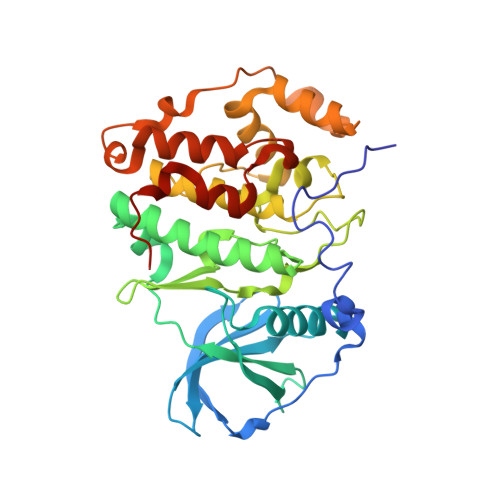Biochemical and cellular mechanism of protein kinase CK2 inhibition by deceptive curcumin.
Cozza, G., Zonta, F., Dalle Vedove, A., Venerando, A., Dall'Acqua, S., Battistutta, R., Ruzzene, M., Lolli, G.(2020) FEBS J 287: 1850-1864
- PubMed: 31661600
- DOI: https://doi.org/10.1111/febs.15111
- Primary Citation of Related Structures:
6HOP, 6HOQ, 6HOR, 6HOT, 6HOU, 6HOV - PubMed Abstract:
Protein kinase CK2 is an antiapoptotic cancer-sustaining protein. Curcumin, reported previously as a CK2 inhibitor, is too bulky to be accommodated in the CK2 active site and rapidly degrades in solution generating various ATP-mimetic inhibitors; with a detailed comparative analysis, by means of both protein crystallography and enzymatic inhibition, ferulic acid was identified as the principal curcumin degradation product responsible for CK2 inhibition. The other curcumin derivatives vanillin, feruloylmethane and coniferyl aldehyde are weaker CK2 inhibitors. The high instability of curcumin in standard buffered solutions flags this compound, which is included in many commercial libraries, as a possible source of misleading interpretations, as was the case for CK2. Ferulic acid does not show any cytotoxicity and any inhibition of cellular CK2, due to its poor cellular permeability. However, curcumin acts as a prodrug in the cellular context, by generating its degradation products inside the treated cells, thus rescuing CK2 inhibition and consequently inducing cell death. Through the intracellular release of its degradation products, curcumin is expected to affect various target families; here, we identify the first bromodomain of BRD4 as a new target for those compounds. DATABASE: Structural data are available in the PDB database under the accession numbers 6HOP (CK2α/curcumin), 6HOQ (CK2α/ferulic acid), 6HOR (CK2α/feruloylmethane), 6HOT (CK2α/ferulic aldehyde), 6HOU (CK2α/vanillin) and 6HOV (BRD4/ferulic acid).
Organizational Affiliation:
Department of Molecular Medicine, University of Padua, Padua, Italy.




















